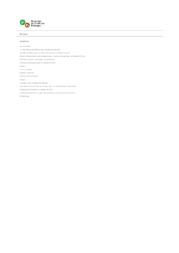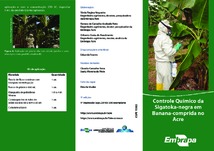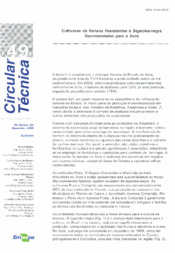Project aims to improve quality of plantain production
Project aims to improve quality of plantain production
With the aim of generating innovation and strategies to reduce losses in production and postharvest of plantains (Musa spp. cv. d’Angola), Embrapa Acre, in cooperation with family farmers, will research new techniques to improve the quality of bananas and plantains produced in Acre. The efficacy of andiroba and copaiba oils for anthracnose control will be tested, as well as other applications for product quality assurance. Anthracnose is a disease that manifests itself during transportation, storage and ripening of the fruit, thus it lowers the quality of the product and causes losses to farmers.
Low quality in postharvest is considered one of the main technological problems of banana and plantain farming in the state. The project 'Technological innovations applied to plantain postharvest as support to implement a risk mitigation system for black sigatoka in Acre' was approved by the bank Banco da Amazônia to last 36 months, and will be carried out by Embrapa Acre. 'This project seeks effective and sustainable solutions to reduce losses and improve the quality of plantains at this stage of production', says Embrapa Acre’s researcher Virgínia Álvares.
Banana and plantain farming is one of the main sources of income in the state. Despite the benefits generated, the sector faces a major problem in the postharvest: anthrachnose, a disease caused by the Colletotrichum musae fungi.
Black Sigatoka is another obstacle to plantain and banana production not only in Acre but also in the whole world. The disease, caused by the Mycosphaerella fijiensis Morelet or Paracercospora fijiensis Morelet fungi, affects the leaves of banana trees, prevents photosynthesis and interferes with production. Where there is no pest control, the fungi's action can cause losses of up to 100% of the fruit.
The presence of the disease and the lack of a Risk Mitigation System (RMS) are factors that make it impractical to sell plantains and bananas outside of Acre. 'Until there is a postharvest treatment of the fruit, we will not be able to enter the markets of other states', says farmer Gersi de Souza, president of the Associação dos Produtores Rurais do Ramal Campo Novo (Campo Novo Branch Farmers Association - Apruracam).
Capacity-building
In addition to researching ways to combat anthracnose and informing the implementation of a Risk Mitigation System for black sigatoka in Acre, the plan is to build capacity of farmers and technicians from the city of Acrelândia, the state's main banana and plantain producer, on good postharvest practices. 'This partnership contributes to the results and findings of the studies being directly shared with farmers who make a living from banana or plantain farming, as well as to training knowledge multipliers', Virgínia says.
The project includes actions at Aprucaram's Packing House, where tests will be carried out to improve product quality. The structure is being built through a partnership between Acre's Secretariat of Industry, Science and Technology (Seict), Acre's Secretariat of Production and Agribusiness (Sepa) and Embrapa, in the city of Acrelândia, with funds from the International Bank for Reconstruction and Development (IBRD).
According to current legislation, plantains and bananas must be sold in boxes, which indirectly requires the use of correct fruit management in the postharvest stage. This process results in higher durability of the banana and lowers the chances of waste. In Acre, the fruit is still sold in bunches.
Banana and plantain farming
Bananas and plantains are the main fruit crops in the state of Acre, with the largest cultivated area: 7,120 hectares and 88,100 tons produced. It represents the highest production value among perennial crops in the state, with R$ 60.3 billion in 2019. According to the Brazilian Institute of Geography and Statistics - IBGE (2017), Acre has 8,363 agricultural establishments with more than 50 planted banana trees, 87.5% of which are considered family farms. Acrelândia is the city with the highest banana production in the state, with 1,100 hectares of harvested area, in 2020, and a yield of 16,500 tons, which corresponds to 19% of the total produced in that year (IBGE, 2021), with greater focus on plantains.
Priscila Viudes (Mtb030/MS)
Embrapa Acre
Press inquiries
acre.imprensa@embrapa.br
Phone number: +55 68 3212-3250
Collaboration: Kenno Vinicius
Embrapa Acre
Translation: Alessandra Marin, supervised by Mariana Medeiros (13044/DF)
Superintendency of Communications
Further information on the topic
Citizen Attention Service (SAC)
www.embrapa.br/contact-us/sac/




